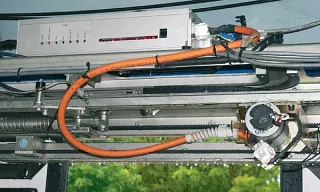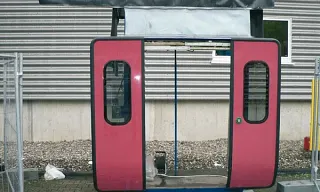Change Language :

readychain® and iglidur® Bearings: Reliable Solutions for Rail Vehicles
Proven Durability Through Rigorous Testing
Hübner GmbH, a global leader in rail vehicle systems, has expanded its offerings to include door systems for rail vehicles and buses. These door-opening mechanisms endure significant operational stress, making durability a top priority. In these demanding applications, igus® readychain® energy chains and iglidur® plain bearings have proven their reliability and efficiency.
In long-term tests conducted under real-world conditions, igus® energy chains have successfully completed over 2 million movement cycles, while iglidur® plain bearings have achieved around 1.7 million double strokes without failure. These results underscore their suitability for the harsh operating environments typical of rail and bus door systems.
New business area: door systems.
Around one and a half years ago, the company decided to supplement the business area product portfolio with an important addition the door systems. A logical step to take when you possess a strong position in the market for rail and transfer systems, but still a challenge as the doors are highly stressed.
This applies in particular to the first concrete order that Hübner acquired in this area: A door system should be made for a southern European regional train. This meant very high opening frequency and a wide temperature range across the year, in which the system must be able to function faultlessly over many years.

Skillfully constructed: despite counter directional movement, it is possible to get by with an energy chain.
Fall back on experience
During this process, Hübner designers could of course fall back on their experience in rail vehicle technology - and they have advanced systematically.
Engineer Uwe Krug, construction manager for window and door systems of the Rails department at Hübner: "We have developed many of the components ourselves, for example, the complete drive. In the case of purchased parts, we basically use standard components, which are subjected to a comprehensive range of tests. " This also applies to the energy chain, which is mounted above the sliding door. It guarantees that the moving energy supply reaches the button with which the passengers open the door and to the closing edges safeguard with anti-trap protection, which is also manufactured by Hübner. Whether an energy chain is required for this purpose was out of the question. Engineer Oliver Rang, Door Systems Construction: "As a result of our investigations on drive development, we know that when cables are not guided it can quickly lead to wearing of the cable jacket." We know this problem from bus joints and entry systems where we also use energy chains. “
"Planned from the start with igus®"
Collaboration partners in this area were established well in advance. Uwe Krug: "From the start we have been planning with igus®. " On the basis of specifications and by means of an initial model of the sliding door, igus® selected an energy chain and with it also delivered a sample of the top-quality, flexible chainflex® cable. Part of the selection parameters dictate that the chain and cable must be able to function at temperatures of down to -40 °C. And the intelligent mechanical construction means that one energy chain is sufficient, although on opening the sliding door two counter-directional movements are executed. The type 06 chain, which is delivered by igus® as a pre-mounted readychain® with cable, one-sided plug, cable marker and connecting angle, is proving its worth not only in laboratory tests, for example in the climatic chamber and in shock and vibration tests, but meanwhile also through practical experience. Regional trains have already been operating since fall 2005 with the new door systems from Hübner - and there have been no problems or complaints so far. In view of the high strains and complex kinematics with the sliding door and entry system, this cannot be taken for granted - and it shows that Hübner engineers, due to the wealth of experience gained in this application area, best adjust their developments according to the usage conditions of rail vehicles.

During the course of the long-term test, the energy chain completed 2 million movement cycles and the plain bearings 1.7 million double strokes.
Two million trouble-free movement cycles
Admittedly the positive experiences of clients have not resulted in overall satisfaction. Markus Hühn, in charge of electronic development in the rails division of Hübner GmbH: "On the company's premises, we have constructed a door system which under real weathering conditions continually opens and closes in long-term tests. " This trial has been running for 22 months now and the counter reading has got to 2 million. Oliver Rang: "After around 1.8 million strokes we examined chain and cable and detected no appreciable signs of wear."

In endurance tests plastic plain bearings prove themselves clearly superior to metallic bearings.
Plain bearings: Advantage for plastic
While Hübner collaborated from the outset with igus® on the selection of the energy chain, only in the second stage were the igus® plain bearings made from the self-lubricating high-performance plastic used. Oliver Rang: "In the kinematics of the sliding doors, we first used metallic bearings, however they soon started showing signs of corrosion and also noticeable wearing. "
Only after these experiences did we decide on plastic instead of metal and asked igus® to propose an extremely wear-resistant material with in-built lubricant and very good low-temperature properties, and to supply corresponding plain bearings. They did this successfully, as the long-term test shows. The iglidur® plain bearings have in the meantime completed 1.7 million double strokes and are proving to be just as long-lasting as the energy chains.
More on applied products here
